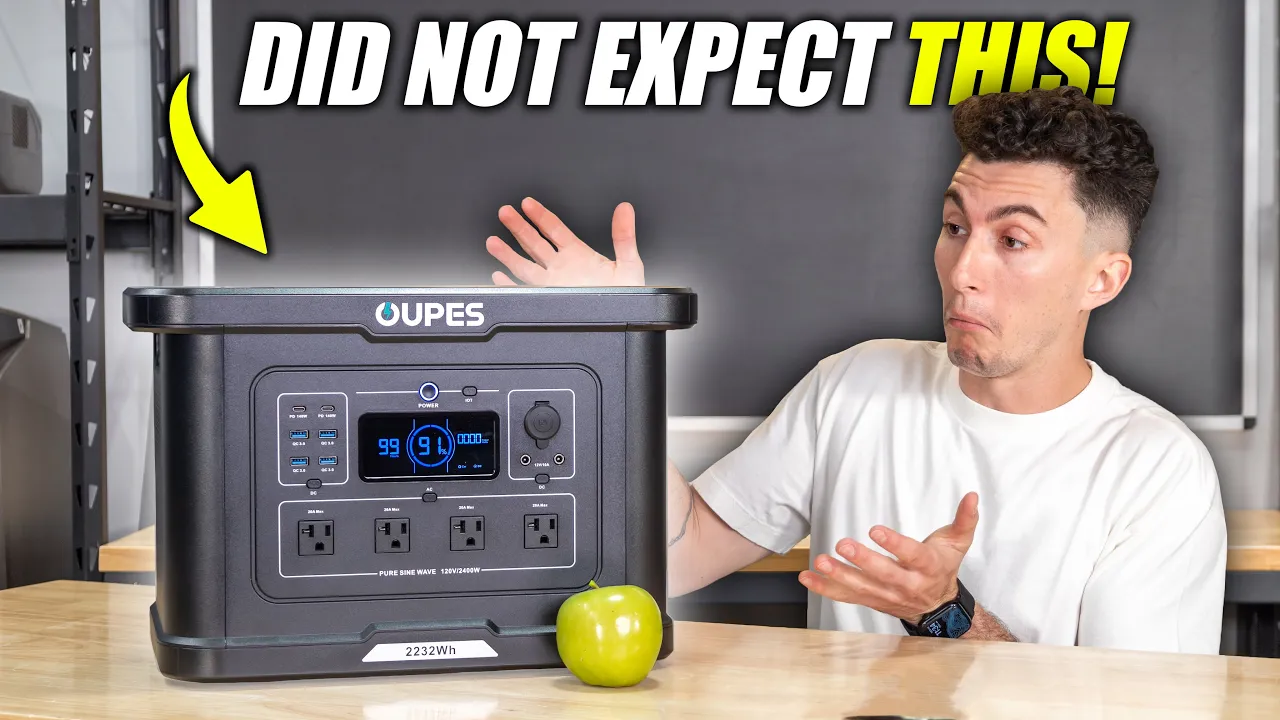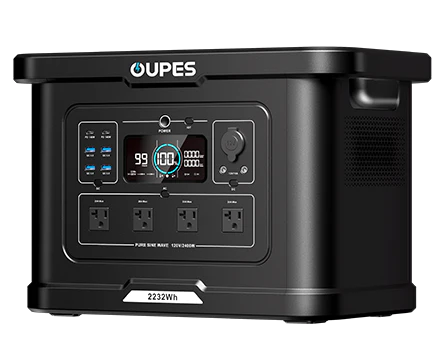

When we previously reviewed the OUPES Exodus 1200, let’s just say it didn’t exactly impress us. In fact, we half-joked that the “Exodus” label might be describing the brand’s journey out of our good books.
Between the slow charging speeds, outdated solar input, limited number of ports, and overall mediocre performance, the Exodus 1200 just felt like a complete miss from OUPES.
In fact, OUPES even acknowledged the shortcomings, going as far as telling us that they felt it was a slightly rushed product release.
But now that they’ve come back with the Exodus 2400, a bigger, more powerful, and hopefully redemption-worthy step up from the first Exodus release, we found ourselves feeling cautiously optimistic. After all, if you ignore the Exodus 1200, we generally view OUPES as one of the top budget power station brands.
So, did they pull it off, or is the OUPES 2400 another “oops”? We put it through our usual set of tests to find out.
Before we dive into all of the things we like and dislike about this little unit, let’s take a quick look at what OUPES has to say about it:
{{review-summary}}
The Exodus 2400 actually impressed us in testing, which is something we haven’t been able to say about many budget stations lately.
The efficiency came in at 84%, which isn’t anything too impressive, but it’s solid for a power station of this class. They say it has a surge capacity of 2,600W, but it didn’t seem to like surging much beyond 2,500W when we tested it. Still, a slightly lower surge rating is to be expected with a low-cost inverter.
The idle power consumption is about 30W per hour. Again, not the best we’ve ever seen, but given the battery size and cost, it’s definitely not a dealbreaker. Unlike the Exodus 1200, the Exodus 2400’s solar input worked reliably, and its UPS function switched over smoothly.
From a usability perspective, the redesigned “mushroom” shape gives the unit a raised edge across the entire upper surface. This also means the two side-mounted handles offer a better grip for lifting. And at just over 45 lbs, it’s also pretty lightweight, so those built-in handles make it really easy to lift and carry.
The AC outlets are also really well-spaced, so you can actually plug in bulkier items like a camera battery or laptop charger without blocking neighboring ports. This might sound like a fairly insignificant design decision, but it’s really important when it comes to practical, day-to-day use.

First and foremost, our performance testing showed that this thing works pretty much exactly as advertised. That might sound like faint praise, but when you’re talking about these budget power stations, that’s not always a given.
Here are just some of the other things we liked about this unit:
Sounds simple, but it actually does what OUPES says it should. The inverter handled its rated load without hiccups, the efficiency was above average for its category, and idle consumption wasn’t excessive. Plus, all of the input and output ports worked flawlessly, and the screen displays information clearly.
In a world of overhyped budget stations that just don’t deliver, honest specs are really refreshing.
We know, this may sound minor, but when you’re camping or working outside, a dim display can be a constant annoyance.
Usually, the display screen is one of the first things you notice with a low-cost power station. Not only do they usually limit the information you can actually access, they’re often barely bright enough to read.
Bucking the trend, the Exodus 2400’s screen is visible in full sunlight, so no cupping your hands over it just to check battery percentage. For such a low-cost power station, the display really exceeded our expectations.
We thought the “mushroom” design was a bit weird at first, but it gives both sides of the unit some really sturdy handles that makes it much easier to carry the unit.
As mentioned, the well-spaced ports also mean you’re not constantly playing outlet Tetris. We’ve reviewed a few different units that have the AC outlets pretty much snug against each other, so you could barely plug in more than one thing at a time. With this design, all four are easily accessible.
The OUPES app is one of the better ones in the budget space. It connects quickly, updates in real time, and keeps things simple without hiding key features behind unnecessary menus.
When you get into some of these low-cost power stations, some just give you a generic app. OUPES provides their own, which means they even put some decent thought into developing their entry-level power stations.
It’s another small thing, but a portion of all of the brand’s sales go towards providing power stations to people in need. Given that they’re already a budget brand, this is pretty commendable, especially given some of the bigger brands, like EcoFlow, give nothing back.
Even though this is clearly a step up from the Exodus 1200, it’s still a cheap power station, and that means you’re going to have to deal with a few compromises.
Here are a few of the areas where we think the OUPES 2400 fell a bit short:
At this point, we’re starting to feel like a broken record, but a built-in light is such an inexpensive and useful addition, especially for camping or during a blackout.
OUPES still refuses to include a light on their power stations, which just feels like a missed opportunity.
The cooling fans are louder than average for a power station of this size. We’re not talking about unbearable noise levels, but it’s definitely noticeable. You wouldn’t want this running in the same room as you while you sleep.
It’s also something for creators to consider, as the noise is loud enough that you’d probably pick it up if you were trying to record audio.
The outer casing feels like it’s made out of a thinner and cheaper plastic than you get with some of the more premium brands. Even compared to a brand like Pecron, which also makes budget-friendly power stations but reinforces their corners with rubber bumpers, the casing on the Exodus 2400 feels a little cheap.
It’s not a major issue given the price point, but even if you just dropped this from a table, you’d probably find yourself sweeping up a few pieces.
We’re nitpicking a bit here, but the 800W solar input isn’t that impressive for a power station with a storage capacity over 2kWh.
OUPES does claim this thing can support dual AC and solar charging at a combined charging speed of 2,200W, but that isn’t going to do too much for those planning to use it fully off-grid.
The OUPES Exodus 2400 is exactly what we hoped it would be: a redemption model that proves the brand can still make affordable power stations that perform reasonably well.
It’s not perfect, and you might need to tolerate the fan noise a bit, but for the price, it delivers solid performance, thoughtful design touches, and just all-around respectable everyday usability.
If you’re looking for a budget station for camping, emergency backup, or light off-grid use, this one’s worth a look, especially if you can grab it closer to that $674 sale price. With that said, if you’re looking for something similar, but a little more rugged, the Pecron E2400LFP might be a slightly more appropriate option.
If you need more power, you could also take a look at the Exodus 2400's older brother, the OUPES Mega 3, which offers a bigger battery and inverter.
